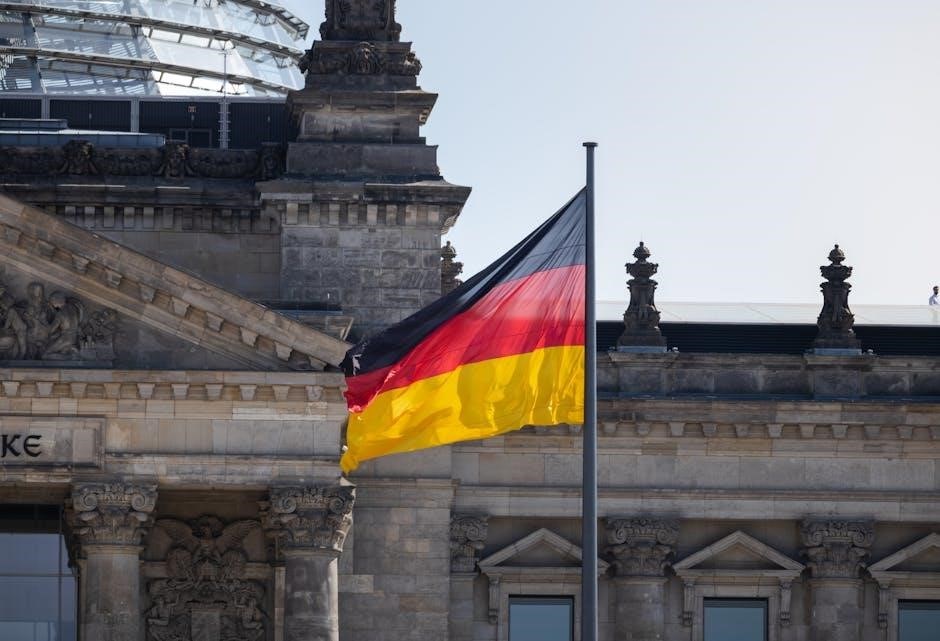The European Union is a unique political and economic union promoting peace, stability, and prosperity among its member states. Originating from post-WWII efforts to unify Europe, it has evolved through key treaties and milestones, shaping a shared vision for a united continent.

Early Beginnings: Post-WWII Context

Post-WWII Europe, devastated and divided, sought unity to prevent future conflict. The Council of Europe emerged in 1949, laying the groundwork for eventual integration and peace.
1.1 The Devastation of World War II and the Need for Unity
World War II left Europe in ruins, with millions dead, injured, or displaced. The continent was economically devastated, and political instability loomed. The war’s end in 1945 highlighted the urgent need for unity to prevent future conflicts. Europe was divided between the Soviet-dominated East and democratic West, raising fears about Germany’s future. This post-war landscape spurred visionary leaders to seek cooperation, laying the groundwork for a unified Europe. The idea of a federal European union re-emerged, aiming to bind nations together through democratic institutions and economic integration, ensuring peace and stability. This period marked the birth of a shared vision for a united continent.

The Founding Years: 1945-1959
The post-WWII era marked the beginning of European cooperation. Visionary leaders sought unity to prevent future conflicts, leading to the Schuman Declaration in 1950 and the Treaty of Rome in 1957, establishing the European Economic Community.
2.1 The Schuman Declaration of 1950
The Schuman Declaration, proposed by French Foreign Minister Robert Schuman on May 9, 1950, laid the foundation for European integration. It suggested pooling coal and steel resources among European countries to foster economic cooperation and prevent future conflicts. This initiative led to the creation of the European Coal and Steel Community (ECSC) in 1951, marking the first step toward supranational cooperation. The declaration emphasized unity, solidarity, and mutual trust, setting the stage for further integration. It symbolized a commitment to peace and prosperity, inspiring subsequent treaties and the eventual formation of the European Union.
2.2 The Treaty of Rome (1957) and the Establishment of the European Economic Community
The Treaty of Rome, signed on March 25, 1957, by six European countries (Belgium, France, Germany, Italy, Luxembourg, and the Netherlands), established the European Economic Community (EEC). This treaty aimed to promote economic integration by creating a common market and customs union among member states. It also laid the groundwork for the European Atomic Energy Community (Euratom). The treaty’s objectives included fostering economic growth, improving living standards, and strengthening peaceful relations among European nations. By creating a framework for shared economic policies, the EEC became a cornerstone of European integration, building on the success of the earlier European Coal and Steel Community (ECSC).
The Swinging Sixties: Economic Growth and Integration
The 1960s marked a transformative decade for Europe, with rapid economic growth and deepening integration. The merger of the European Communities in 1965 consolidated progress.
3.1 The Merger Treaty (1965) and the Creation of the European Communities
The Merger Treaty of 1965 was a pivotal step in European integration, unifying the European Coal and Steel Community (ECSC), the European Economic Community (EEC), and Euratom. Signed on April 8, 1965, it came into effect on July 1, 1967, creating a single institutional framework. This merger streamlined decision-making by aligning policies under one governance structure, enhancing efficiency. The treaty laid the groundwork for a more cohesive European entity, fostering unity and setting the stage for future integration efforts, including the eventual creation of the single market and monetary union. It marked a significant milestone in the EU’s evolution, solidifying its institutional foundations.

A Growing Community: The 1970s
The 1970s marked the EU’s first enlargement, welcoming Denmark, Ireland, and the UK in 1973, and introducing regional policies to reduce economic disparities.

4.1 The First Enlargement: Denmark, Ireland, and the United Kingdom Join in 1973
In 1973, Denmark, Ireland, and the United Kingdom officially joined the European Communities, marking the first major enlargement of the EU’s precursor. This expansion not only increased the membership from six to nine countries but also brought cultural and economic diversity. The UK’s accession, in particular, was significant, as it marked a shift toward greater geopolitical unity. However, challenges such as economic disparities and differing political priorities arose. The EU responded by introducing regional policies aimed at reducing these inequalities. This enlargement set a precedent for future expansions and deepened European integration, laying the groundwork for a more unified and inclusive Europe.
The 1980s: Deepening Integration
The 1980s marked a pivotal decade for the European Union, with efforts focused on deepening economic and political integration. The Single European Act of 1986 aimed to create a single market by 1992, fostering free movement of goods, services, and people. This period also saw the expansion of EU policies into new areas, such as environmental protection and social affairs, further solidifying the union’s framework and setting the stage for future enlargement and cooperation.
5.1 The Single European Act (1986) and the Move Toward a Single Market
The Single European Act (SEA) of 1986 was a landmark agreement that aimed to create a single market within the European Union by 1992. This act sought to remove barriers to the free movement of goods, services, capital, and people across member states. By establishing a clear deadline for achieving this goal, the SEA accelerated economic integration and competitiveness. It also introduced measures to harmonize laws and regulations, ensuring a level playing field for businesses. The SEA marked a significant step toward a more unified Europe, laying the groundwork for future policies and deepening the EU’s internal market, which remains a cornerstone of its economic strategy today.
The 1990s: Maastricht Treaty and the Birth of the EU

The Maastricht Treaty (1993) formally established the European Union, creating a three-pillar system and introducing EU citizenship, marking a significant leap in political and economic integration.
6.1 The Maastricht Treaty (1992) and the Creation of the European Union
The Maastricht Treaty, signed in 1992 and effective in 1993, marked a historic milestone by formally creating the European Union. This treaty introduced the concept of EU citizenship, strengthening the political and social dimensions of European integration. It established a three-pillar structure: the European Communities, Common Foreign and Security Policy, and Cooperation in Justice and Home Affairs. The treaty also laid the groundwork for the Economic and Monetary Union, including the eventual introduction of the euro. By deepening integration, the Maastricht Treaty transformed the European Communities into a more unified and cohesive entity, setting the stage for modern Europe’s political and economic framework.
The introduction of the euro in 1999 marked a significant step toward economic unity in Europe. As the official currency of the Economic and Monetary Union (EMU), the euro replaced national currencies in 12 member states initially. Physical euro coins and banknotes were introduced in 2002, becoming a tangible symbol of European integration. The establishment of the EMU was facilitated by the Maastricht Treaty, which created the European Central Bank to manage monetary policy. The euro aimed to enhance economic stability, promote trade, and strengthen the global influence of the EU. It has since become a cornerstone of the EU’s economic policy and a key element in fostering a unified European identity.

The 2000s: Expansion and Consolidation
The 2000s saw significant expansion with the 2004 enlargement, adding 10 new member states. The Lisbon Treaty (2007) further streamlined EU processes and strengthened its global influence.
7.1 The Enlargement of 2004 and the Addition of 10 New Member States
In 2004, the European Union underwent its largest expansion to date, welcoming 10 new member states. These included Cyprus, the Czech Republic, Estonia, Hungary, Latvia, Lithuania, Malta, Poland, Slovakia, and Slovenia. This historic enlargement marked the EU’s commitment to unity and integration, particularly with former Soviet bloc countries. The accession followed extensive preparations and reforms by the candidate countries, aligning their economies and legal systems with EU standards. The 2004 enlargement not only deepened European integration but also symbolized the triumph of democracy and market economies over decades of communist rule. It paved the way for further consolidation and strengthened the EU’s role as a global player.

The 2010s: Challenges and Crisis Management
The 2010s saw the EU face significant challenges, including the European Sovereign Debt Crisis and the migrant crisis, testing its economic and political resilience and unity.
8.1 The European Sovereign Debt Crisis and Its Impact on the EU
The European Sovereign Debt Crisis, beginning in 2009, exposed deep economic and political fissures within the EU. Countries like Greece, Ireland, and Portugal faced severe financial instability, prompting bailouts and austerity measures. The crisis highlighted weaknesses in the Eurozone’s economic framework and led to the establishment of the European Stability Mechanism (ESM) in 2012. It also spurred debates on fiscal integration and long-term structural reforms. The crisis strained inter-member relations but ultimately strengthened the EU’s crisis management capabilities, fostering greater solidarity and paving the way for measures like the Next Generation EU recovery plan.
The 2020s: Modern Challenges and Adaptations
The 2020s brought unprecedented challenges, including the COVID-19 pandemic, Brexit, and Russia’s invasion of Ukraine. The EU adapted by strengthening solidarity, launching recovery plans, and redefining its global role.
9.1 The COVID-19 Pandemic and the EU’s Response
The COVID-19 pandemic posed significant challenges to the EU, testing its unity and crisis management capabilities. In response, the EU launched coordinated measures to combat the virus, including vaccine procurement and distribution through the European Vaccine Strategy. Economic recovery plans, such as the NextGenerationEU program, were implemented to support member states’ economies. The EU also ensured the free movement of medical supplies and coordinated border management to maintain internal market functionality. These efforts highlighted the EU’s ability to adapt and act collectively in the face of unprecedented global crises, reinforcing its role as a unified entity in safeguarding the well-being of its citizens.
9.2 Brexit and the EU’s Future
Brexit marked a significant turning point in the EU’s history, as the United Kingdom became the first member state to leave the union in 2020. This departure prompted the EU to reflect on its identity and future trajectory. While Brexit presented challenges, such as adjusting to the loss of a major economic and political partner, it also spurred renewed commitments to deeper integration and modernization. The EU has focused on strengthening unity among remaining members, addressing concerns over sovereignty, and ensuring policy alignment. Additionally, Brexit has emphasized the importance of the EU’s role in addressing global challenges like climate change and digital transformation, reinforcing its mission to foster prosperity and stability for its citizens.
